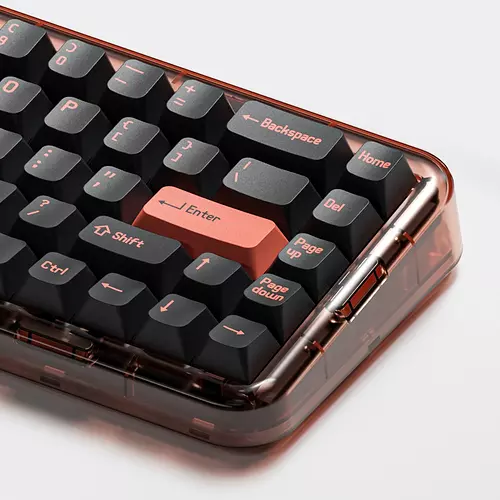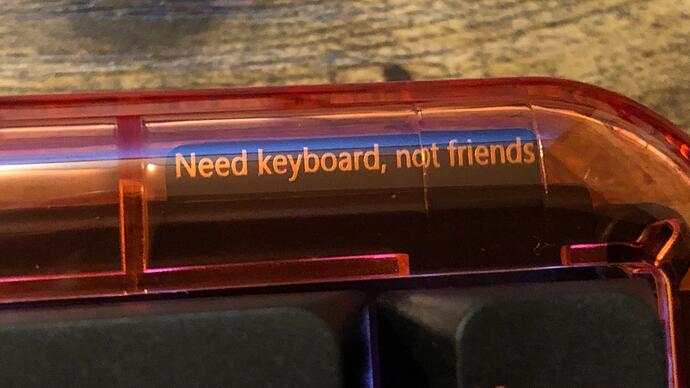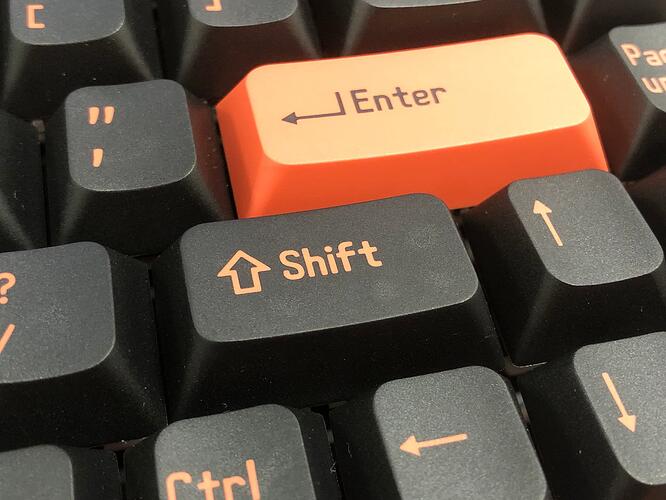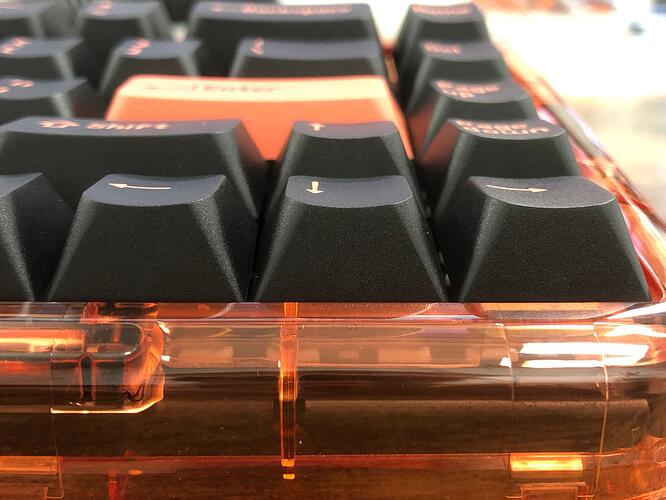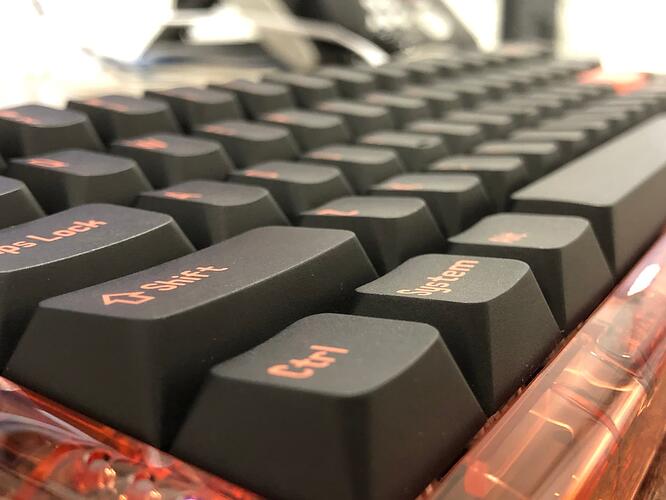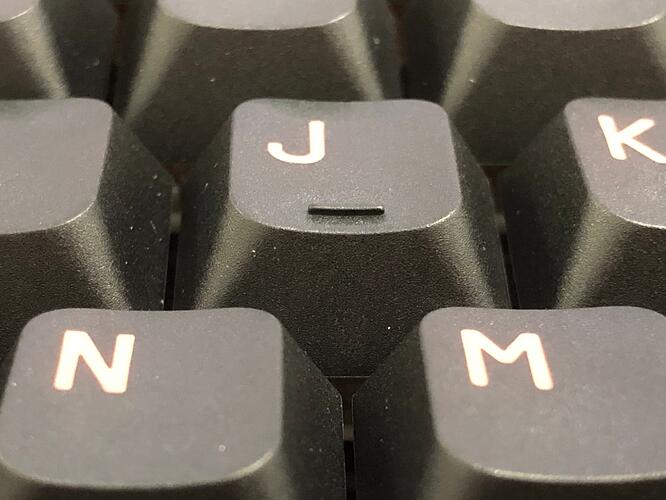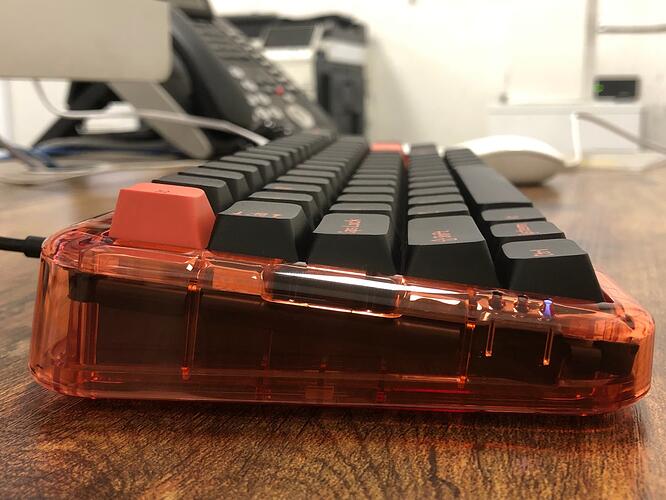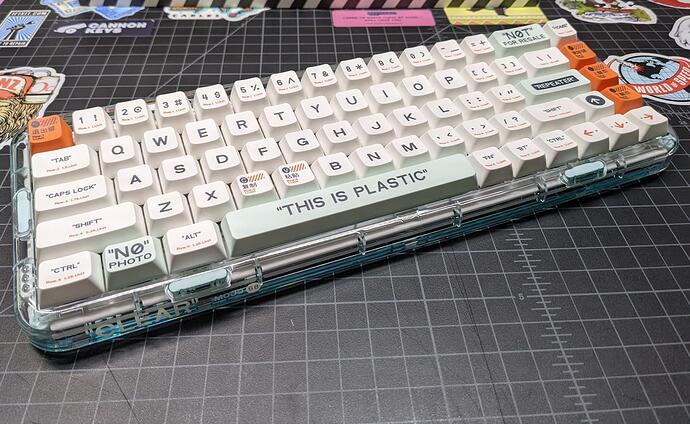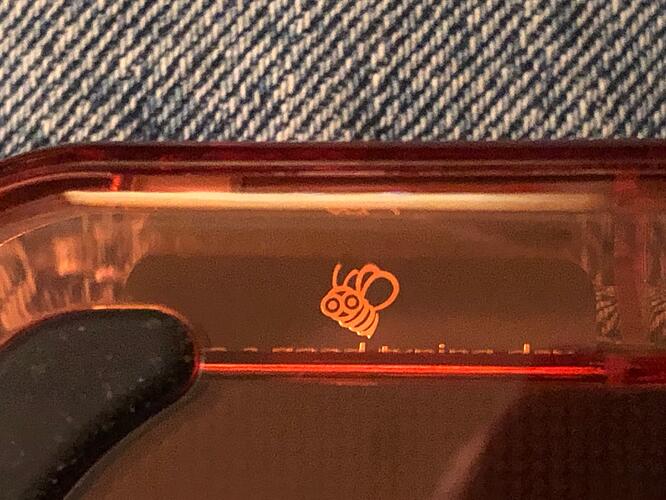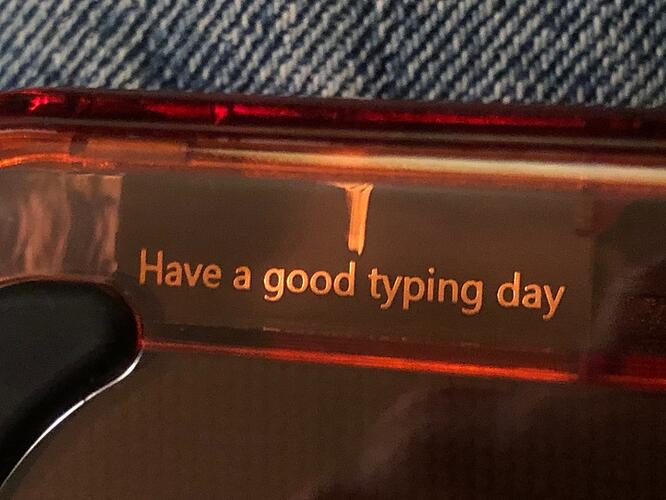After my keeb arrived in the mail, MelGeek emailed me and asked if I’d be willing to write a review on their site. It took me an embarrassingly long time to find where the darn review button was, so I’d written a more full review I’ll be posting on my site - figured I’d share it here as well. Here’s my few-days-in review:
Mojo68 Pigeon
This keyboard has quite a few things in common with its market-peers; the layout, the mounting style, the hotswap, the bluetooth, etc. - but of course much more interesting are the things that separate it from keyboards like the NK65EE, KBD67L, TKC Portico, Bakeneko65, and others.
TL;DR: This is a very good no-fuss, ready-to-go, super-versatile keyboard that can have an excellent typing experience with minimal tuning.
8.75 / 10 - Really Darn Good
Aesthetics:
This is a pretty unique looking keyboard in the 65% “entry-custom” bracket. I think it looks like an alternate-universe peripheral for the early iMacs with tube displays and colored translucent plastic panels. The early 00’s OSX “Aqua” look compliments this family of keebs for sure.
Beyond featuring rounded corners and clear polycarbonate plastic, the design is quite thoughtful both in function and form. Everything from the placement of the support ribs to the shape of the gasket dampeners is considered from both a functional and visual perspective - it’s not necessary, but I appreciate it none the less. Like the Apple stuff I mentioned before, this is a product that has an artfully-crafted visual presence on the desk, and that’s part of what you’re paying for.
Features:
When it comes to being feature-rich, the Mojo68 is very competitive. If you can think of a box to check, chances are there’s already a check in it:
- Gasket mounted
- 5-pin Hot-swap
- South-facing
- Remappable via software → firmware
- Works with everything
- 3 connection types; usb, wireless reciever, bluetooth
- Dedicated toggle switch for these modes
- Can pair with and switch between up to 8 devices
- Dampening everywhere
- Includes factory lubed switches
- Includes factory lubed stabilizers
- Includes keycaps in one of three MelGeek-designed profiles
- Assembled and ready-to-go from the box
- Has RGB if you’re into that
- Plastic switch plate, yes that’s a good thing
Priorities and Distinctions:
True, it may not be completely perfect from a features perspective, depending on one’s priorities: It has plate-mounted stabs, which not everyone prefers - and it’s not intended to be dis-assembled by the user. If you break a socket, you may be in for a challenge if you want to fix it - and the various tamper-evident stickers make it extra clear this keyboard is not meant to be taken apart with any regularity. You’ll need some fairly specialized tools if you want to take the case off without damaging it - or some legendary fingernails.
This isn’t necessarily a negative, just a design choice to be aware of: this is not a kit or custom keyboard - this is a complete pre-built keyboard with hot-swap sockets and a construction style informed by custom keyboards. More or less, this is a “custom keyboard” as a ready-made product - and I think that’s actually quite cool in general - just something to be aware of while considering one’s priorities. From this perspective, the plate-mounted stabs actually make perfect sense - in the event you want to tune or replace them, you won’t have to open-up the case to do so - but you would if they were the traditionally-favored screw-in type. Given this keeb isn’t really meant to be opened, plate-mounted stabs are indeed the more user-friendly choice.
User Experience:
Since this is a pre-built, ready-to-go keyboard, I’ll approach it from that perspective. Right out of the box, this keeb offers an impressive experience:
- The factory-lubed switches are comfortably above-average in quality
- The dampened mounting eliminates hot-spots and absorbs harsh vibrations
- The south-facing hot-swap sockets maximize cap/switch compatibility
- The plastic plate pairs well with the other dampening to encourage a clean sound and feel
- The factory-lubed stabs perform admirably, but could still use tuning
- The stock caps are good quality
- The wireless and bluetooth functions work well and are easy to use
Just trying the keys with the keeb still half in the bag, it was clear to me the design is thoughtful and effective. Just about every iteration of “gasket” mounting I’ve seen is a little different and this is no exception, but what this has in common with the rest is that it dampens harsh vibrations - and that in turn improves both the sound and feel while eliminating the hot-spots that come from stand-off mounting. These benefits are clear from the first keystroke, and that’s a good first impression I can appreciate.
The stock stab experience is somewhere between Ducky (better) and everything else (not as good); they are smooth and don’t have a dry rattle - but they do have some rattle and definitely tick. The pre-tuned stabs that came with a KBD67L R1 were better, but all subsequent runs don’t come with pre-tuned stabs and aren’t as good as the Mojo’s in that sense. NK65’s factory stab lubing isn’t half as good. Most kits just come with bone-dry stabs - the Mojo’s at least have some kind of decent quality PTFE-looking grease on there.
I mentioned before that the Mojo68 comes with one of three MelGeek-designed profiles; this Pigeon version comes with MCR. These are double-shot ABS keycaps color-matched to the case, and the profile is roughly familiar to Cherry with a few changes. Like Cherry, it is relatively low-profile and trends toward a clacky sound. Compared with Cherry (and GMK specifically), these caps are a bit thinner - but not as thin as Tai-Hao, for example. The top surfaces are more wide than Cherry profile, and scooped a bit less deeply. The corners are more rounded, giving them a very retro-modern feel, especially with the chosen typeface. The angle is also a bit different, with MCR trending towards but not completely embracing a flat sculpt. Coming from Cherry or OEM, it’s not a big adjustment and should feel reasonably familiar - and hey, you can even flip the spacebar if you’re among the enlightened. 
Tuning the experience:
Beyond that, typing on the Mojo68 is very satisfying for a stock keyboard - though like just about any stock keyboard, it leaves a little to be desired for those of us spoiled by tuned components. Fear not, lube enjoyers! Even if you don’t have a set of plastic spudgers or even a screwdriver, you can still tune these stabs. In fact, you don’t even need to take them out - I’ll tell you how I took all the rattle out of these already smooth-feeling stabs. It took two quick and easy steps:
1.) Using a pipette / syringe, inject some grease similar to what’s already there around the wire where it sits inside the stab stems. I used 205g0 because that’s what I had around, but something thicker like 206g2 would probably be even better. I just put some on top of the wire where it goes into the stem, and kind of all around it on the other side where the wire terminates.
2.) Get some PTFE (Teflon) thread tape, and apply a small piece folded one to two times on top of the stab stem mounts with your finger - push it down so it starts to deform around the cross mount. From there just mount your cap normally.
Whether due to tolerances, lubricant contamination, or a bit of both, the stab stems seem to have a bit of trouble gripping the MCR profile caps that come with the Pigeon edition of the Mojo68 - this non-adhesive and very soft tape is a safe way to improve this grip without damaging the cap stems. Without it, an enthusiastic off-center smack of the backspace or other stabilized key could have it lift-off one side of the stab a bit, causing any rattle or weird feelings to intensify. The thread tape completely eliminates this in most cases, and works great on the stock stabs for the Mojo68.
Applying the lube and thread tape only took a couple minutes, and is the only tuning I felt I had to do with this keyboard. Those two simple steps pushed the sound and feel of this keeb the rest of the way into totally satisfying territory; I could use this keeb every day for the rest of my life and be quite happy. This keeb is quite good right from the box - well above average - but with just a little bit of tuning the experience becomes genuinely excellent.
Character of the Keyboard:
On to some more esoteric stuff like “sound” and “feel” - probably the stuff most of you are really here for.
While it isn’t super flexy, the gasket mounting definitely does the job of dampening vibrations and offering consistency across the deck. The feel is crisp and the sound is clacky, but neither are harsh, having the edge taken-off by the copious foam and silicone content in this keyboard’s construction.
At least with the MCR profile caps that come with this Pigeon version (as well as the Neon and Retro versions), the sound trends towards higher-pitched. That’s not to say you can’t have a deep and thocky sound going on with this keeb - just that Gateron Pros and MCR caps pair up for a pretty high-pitched, sharp chorus of clacks. Very clean clacks, thanks to the aforementioned dampening, mounting, plate material, and factory lubrication.
Here’s a recording of typing on the Mojo68 Pigeon in its stock form:
That said, there’s a touch of housing sharpness to the Pros, which I think could be addressed with films - and the aforementioned stab rattle that can be tamed with a little squirt of grease here and there.
While I found the Yellow Pros to be quite nice, I decided to try swapping-in another of my favorite switches, the TTC Matrix Tactile. These switches are among those that generally don’t need films, and as expected offer a bit more consistent a top-out sound as a result. Slightly less so than the Gaterons but still on the high-pitched end of things with the MCR caps especially, this setup of the Mojo68 is positively clack-tastic - snappy and satisfying.
Here’s a recording of the Mojo68 Pigeon with the TTC tactile switches and easy-mode tuned stabs:
Some other funny details; a little tag of the PCB extends beyond the rest at the top-right corner of the board and says “Need keyboard, not friends” - I laughed. The serial / qc sticker was attached to the protective plastic wrapping, not the case. The “MOJO” logo on the manual is cheekily similar to RAMA’s. The bottom silicone has a cool texture even though it doesn’t really need to. This keyboard is pretty but deffo shows fingerprints and dust on its glossy surface.
Comparisons:
The Pigeon edition of this keyboard I’ve typed this review on sells for $199 USD plus tax and shipping. Considering its quality and competition, I’d say this is very competitive.
At first glance, many of its middle-market peers seem less expensive at first - until you consider almost none of them come with switches or keycaps, and certainly don’t come assembled or ready to use. This is an “entry-level custom” that’s ready to rock right from the box, and that is indeed a point of distinction. Taking all of this into account, the $200 price-range is right on-par with competitors like the Portico, KBD67 lite, and NK65 Entry Edition.
Compared with the NK65, the Mojo68 is right on-par when it comes to Aesthetic refinement - but frankly blows it away when it comes to mounting style and consistency of sound and feeling. Of course it looks very different, but generally speaking both of these keebs are pretty outstanding when it comes to looks. When it comes to construction and features, though - the Mojo takes an easy win. If you need a complete keyboard, go for the Mojo. If you already have switches and caps, at least consider the NK, as you’ll be saving a hundred bucks and they do have polycarb plates now.
Compared with the Portico, the Mojo is a fair bit more heavy and planted on the desk, and with a less slim bezel profile. Like with the NK above, the typing angle is more shallow on the Mojo than the Portico. Also like the above, the Mojo enjoys wireless features the others do not. Like most of its peers, the Mojo can be customized in software - but unlike many of them, its through bespoke software instead of QMK and/or VIA.
Compared with the KBD67L, the Mojo has an additional wireless communication type available, and a physical switch to toggle between communication modes. In stock form, the Mojo is heavier, and a bit less bouncy owing to its shorter feet and more firm construction. Sound trends towards a higher pitch than the 67L. The Mojo’s plastic plate has a tighter grip on switches than the 67L’s, which in some cases is a bit loose. So far all the switches I’ve tried in the Mojo have felt secure in their sockets.
Compared with all three of the above, the Mojo is of course less tinker-friendly. It’s plenty easy to swap and tune switches and stabs (and of course caps), but it certainly isn’t the modular system the KBD67 line has become, and doesn’t have quite the aftermarket support for things like plates that either any of the other three currently enjoy.
Conclusions:
If you want to type on a custom keyboard without diving into a new hobby or having to learn stuff about building keyboards (or paying anyone else to do it), the Mojo line is going to be worth a look for you. Even if you do like the hobby side of keebs, it’s still worth a look for the quality / price / aesthetic value. No, it’s not the best keeb for deep tinkering, but it is indeed a quality input device with plenty of room for easy customization.
If you’re down for just a little bit of tuning, you can take this from an above-average experience to an excellent one. The only thing you have to take off are the caps, and the tools for that come in the box. Nice! All you’ll need is some of that PTFE tape, a bit of general purpose lubricant, and a pipette of some kind.
The Mojo68 in general and especially the Pigeon edition are very competitive in their bracket, and definitely offer some distinctions to set themselves apart from the rest. If you’re looking for a 65% keyboard in anything resembling the “entry-custom” segment, this one is at very least worth your serious consideration. When it comes to versatility and accessibility, it’s really quite hard to beat, if not currently impossible. When it comes to aesthetics and typing quality at the price, the Mojo68 remains very competitive. If you do lots of tinkering and switch-swapping, something like a KBD67L or Portico might be more your speed, but you could still do a whole lot worse than the Mojo and still have a great time.
All in all, this keyboard is a refreshingly-solid competitor in an increasingly growing segment - a segment which happens to already be my favorite. Keyboards like this are positive milestones in accessible input-device development for the masses, and I think that’s pretty cool.
![]()
